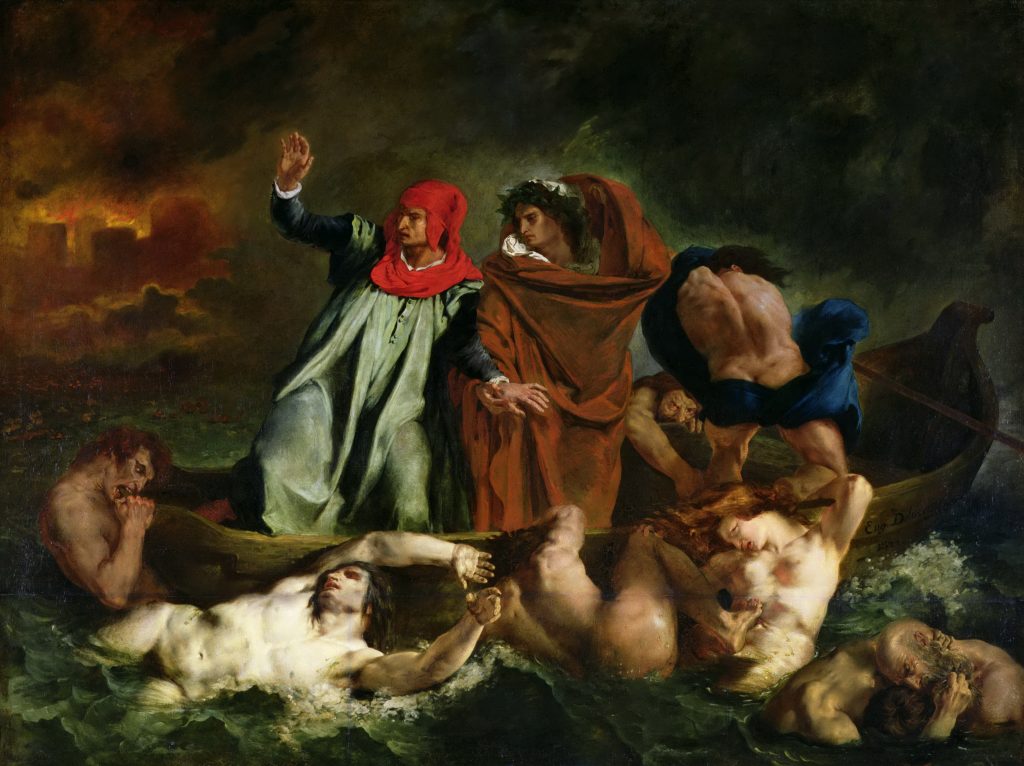Masterpiece Story: Portrait of Madeleine by Marie-Guillemine Benoist
What is the message behind Marie-Guillemine Benoist’s Portrait of Madeleine? The history and tradition behind this 1800 painting might explain...
Jimena Escoto 16 February 2025
Welcome to Hell—tonight, our guide will be Virgil, Dante, and of course Eugène Delacroix. The Barque of Dante, the first major painting by French Romantic painter Eugène Delacroix, is full of mystery and gloom. Let’s unravel it piece by piece.
Depicted on the canvas are the events of canto eight of Dante’s Inferno. Dante along with his guide, the Roman poet Virgil, are crossing the river Styx. As their boat crosses the water the tormented souls that inhabit it are attacking them. Dante loses his balance, but Virgil steadies him. The third figure in the boat is Phlegyas, who serves as the boatman. Even though the figures are in open water, the scene is claustrophobic. There seems to be no way out, only the continuance of their journey, the way ahead. Virgil seems somewhat calm but is focused on Dante. It is his duty to ensure that Dante goes through the circles of Hell to finally reach Heaven and Beatrice. On the other hand, Dante appears frightened and shocked.

Eugène Delacroix, The Barque of Dante, 1822, The Louvre, Paris, France.
The focus of the painting is the figures on the bottom part of the canvas, the tormented souls. Delacroix presents them with great variety in their positioning and great care in their coloring. The bodies are contorted with great pathos and are full of emotion. After all, this is the fifth circle of Hell which is devoted to the sin of anger. The main inspiration for them is the first true masterpiece of the Romantic movement in France, The Raft of the Medusa by Theodore Gericault.
Stylistically, the Barque of Dante stands between two artistic movements, Neoclassicism and Romanticism. Following Neoclassicism, the painting is organized with a vertical and horizontal axis. The main horizontal axis is the boat itself and the main vertical is Virgil and Dante standing upon it. Meanwhile, we find romantic elements in the abundance of emotion throughout the canvas: the socked Dante, and the desperate tormented souls. Mind you, Romanticism is all about emotion, but that emotion does have to be positive. Another thing along the lines of Romanticism is the coloring. The brushstrokes are vigorous, giving the sense of the wind flapping the robes of the men on the boat and the turbulent waters. Behind them, with yellows, reds, and browns, the city of Dis looks like a furnace.
In 1822, at the age of 22 years old, Delacroix presented this painting at the French Salon. It was met with great success and was bought by the French government. Today, it hangs in the Louvre in Paris.
A young and bold Eugene Delacroix delivers his first masterpiece. He will soon go on to be regarded as the frontrunner of the French Romantic movement. To this day he is more well known for his orientalist paintings and of course, Liberty Leading the People. However, it is worth being aware of where his artistic journey began—with Dante’s Divine Comedy.
DailyArt Magazine needs your support. Every contribution, however big or small, is very valuable for our future. Thanks to it, we will be able to sustain and grow the Magazine. Thank you for your help!